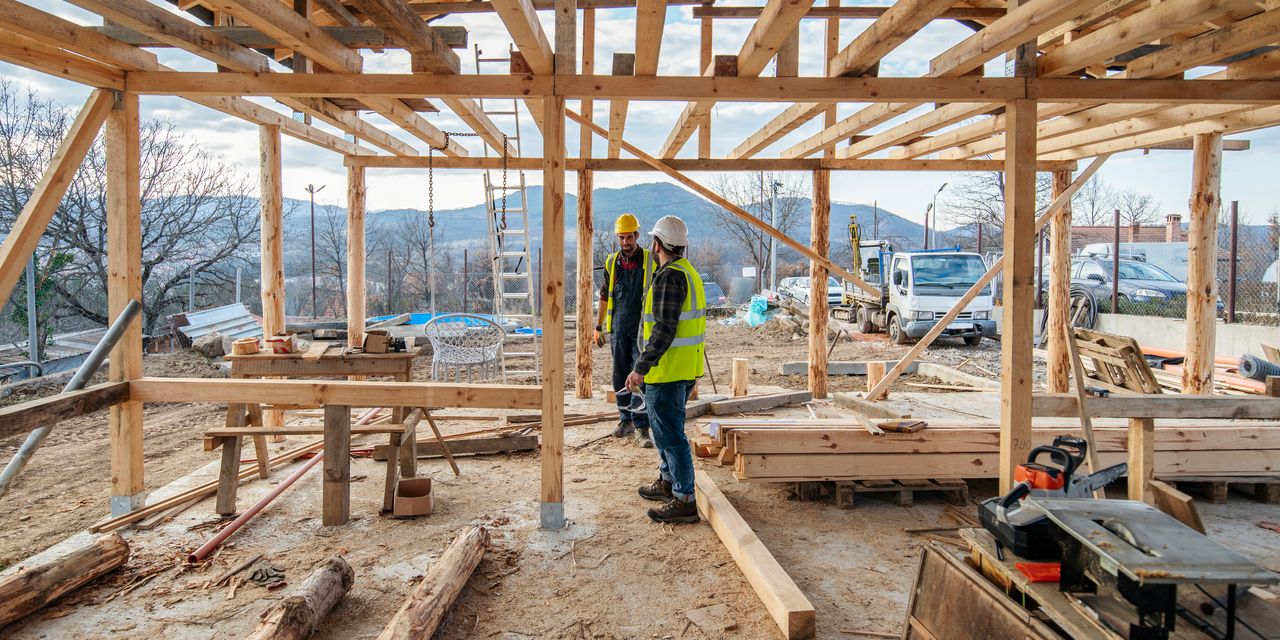At a time when mortgage loan rates have soared to their highest levels since 2000, it might surprise you that some analysts think this is a good time to buy shares of large home builders. But there are a number of good reasons for long-term investors to consider buying home builders’ stocks now, as outlined by Oppenheimer & Co. analysts Tyler Batory and Jonathan Jenkins in a note to clients on Thursday.
Only four home builders are included in the S&P 500
: D.R. Horton Inc.
DHI,
Lennar Corp.
LEN,
NVR Inc.
NVR
and PulteGroup Inc.
PHM.
To screen the home-building space, we looked at the S&P 1500 Composite Index
,
which is made up of the S&P 500, the S&P 400 Midcap Index
and the S&P Small Cap 600 Index
and includes 17 home builders.
If you would like to take a broader approach to the residential-construction space using exchange-traded funds, the iShares U.S. Home Construction ETF
holds 46 stocks, while the SPDR S&P Homebuilders ETF
holds 35 stocks. In addition to home builders, both ETFs invest in suppliers to the industry, such as Builders FirstSource Inc.
BLDR,
Floor & Decor Holdings Inc.
FND,
Home Depot Inc.
HD
and Lowe’s Cos. Inc.
LOW.
3 reasons to consider home builders’ stocks now
1. High mortgage rates have increased demand for newly constructed homes.
The national average rate for a 30-year mortgage loan was about 7.7% last week, increasing from about 7.5% the previous week, according to the Mortgage Bankers Association.
“The rate lock-in effect remains alive and well,” the Oppenheimer analysts wrote. If you have owned a home for several years, it might be financed by a loan with a very low rate, making you reluctant to move and face much higher payments on a high-rate loan. The Oppenheimer analysts cited a 9% decline in newly listed homes for sale in September from a year earlier and added that a limit to supply “funnels demand toward new homes, especially of the larger builders, given their sophisticated pricing tools and ability to offer mortgage incentives.”
According to Batory and Jenkins, the largest 10 U.S. builders had a 42.6% market share for new construction in the U.S. during 2022, up from 27.4% in 2017 and 22.6% in 2005, with a few changes in the makeup of the top 10 from the previous periods.
In 2022, the four home builders included in the S&P 500 — D.R. Horton, Lennar, NVR and PulteGroup — had a 31.6% share, up from 18.5% in 2017 and 12% in 2005. According to the Oppenheimer analysts, the largest builders have been continuing to increase their market share in 2023, and the trend is improving profit margins “as larger companies get more leverage on their fixed costs.”
2. Despite slowing industry growth, home builders’ stocks have risen this year and remain at low valuations to expected profits.
The S&P Composite 1500 Homebuilding industry group — the 17 stocks in the index weighted by market capitalization — has returned 36.2% this year with dividends reinvested, compared with a 14.4% return for the full S&P Composite 1500 and a 15.5% return for the S&P 500.
Now let’s look at forward price-to-earnings valuations for all three, which are based on rolling prices and weighted aggregate 12-month earnings-per-share estimates among analysts polled by FactSet:
| Industry group or index | Forward P/E | 5-year average P/E | 10-year average P/E | Current P/E to 5-year average | Current P/E to 10-year average |
| S&P Composite 1500 Homebuilding industry group | 7.8 | 8.8 | 10.7 | 89% | 73% |
| S&P Composite 1500 | 17.7 | 18.6 | 17.5 | 95% | 101% |
| S&P 500 | 18.3 | 19.0 | 17.8 | 96% | 103% |
| Source: FactSet | |||||
With this year’s market rally following last year’s broad decline, you might not be surprised to see that the broad indexes are trading close to the five- and 10-year average valuations, even as the home builders are trading at a significant discount to their 10-year average valuation. Now take a look at how the three groups have performed since the end of 2021:
The broad indexes haven’t yet made up for the 2022 decline, which reflects the new environment in which income seekers can easily find yields above 5% in bank CDs or shorter-term U.S. Treasury obligations, while 10-year Treasury bonds
were trading at yields of 4.64% and 20-year Treasury bonds
were yielding nearly 5% Thursday morning. (Read a discussion on whether or not tax-exempt municipal bonds might work for you in the current rate environment, based on your tax bracket.)
It is interesting to see that despite being in a new environment, with high interest rates stifling the housing market as a whole and tempting some investors away from stocks, the home builders have held up better than the broad market.
The Oppenheimer analysts wrote that home builders’ stocks “screen inexpensively” relative to long-term valuations. “We think fears over the recent spike in interest rates have mostly been priced into shares,” they wrote.
It would seem a good percentage of investors agree that valuations are attractive, from this year’s stock performance.
Here’s a look at relative P/E levels for the 17 home builders in the S&P Composite 1500, sorted by market capitalization:
| Home builder | Ticker | Forward P/E | 5-year average P/E | 10-year average P/E | Current P/E to 5-year average | Current P/E to 10-year average | Market cap. ($bil) |
| D.R. Horton Inc. | DHI | 7.5 | 8.7 | 10.3 | 86% | 72% | $36.8 |
| Lennar Corp. Class A | LEN | 7.6 | 8.3 | 10.3 | 92% | 74% | $28.6 |
| NVR Inc. | NVR | 12.9 | 14.1 | 14.7 | 91% | 88% | $20.2 |
| PulteGroup Inc. | PHM | 6.1 | 7.4 | 9.6 | 83% | 63% | $16.6 |
| Toll Brothers Inc. | TOL | 6.1 | 7.7 | 10.4 | 78% | 58% | $8.1 |
| Taylor Morrison Home Corp. | TMHC | 5.6 | 6.1 | 8.0 | 92% | 70% | $4.7 |
| Meritage Homes Corp. | MTH | 5.7 | 7.5 | 8.7 | 77% | 66% | $4.4 |
| KB Home | KBH | 6.0 | 7.3 | 9.6 | 82% | 63% | $3.6 |
| M.D.C. Holdings Inc. | MDC | 7.1 | 8.1 | 10.2 | 88% | 69% | $3.0 |
| Tri Pointe Homes Inc. | TPH | 6.6 | 7.4 | 9.1 | 89% | 72% | $2.7 |
| Frontdoor Inc. | FTDR | 16.9 | 21.8 | 21.8 | 77% | 77% | $2.5 |
| Cavco Industries Inc. | CVCO | 11.5 | 18.5 | 22.2 | 62% | 52% | $2.4 |
| M/I Homes Inc. | MHO | 4.5 | 5.8 | 7.9 | 77% | 57% | $2.3 |
| LGI Homes Inc. | LGIH | 8.2 | 9.6 | 9.4 | 85% | 87% | $2.3 |
| Century Communities Inc. | CCS | 7.3 | 6.3 | 6.9 | 116% | 105% | $2.1 |
| Green Brick Partners Inc. | GRBK | 6.0 | 7.4 | 10.4 | 81% | 58% | $1.9 |
| Patrick Industries Inc. | PATK | 8.9 | 9.8 | 12.3 | 91% | 72% | $1.6 |
| Source: FactSet | |||||||
Click on the tickers for more about each company, fund or index.
Click here for Tomi Kilgore’s detailed guide to the wealth of information available for free on the MarketWatch quote page.
3. The home builders are in good financial shape.
According to the Oppenheimer analysts, large home builders have “derisked” by lowering the combined ratio of debt to equity to the mid-teens from 40% on average during the mid-2000s.
At the same time, the companies have been more careful with their spending and have also used buybacks to reduce their share counts, which boosts earnings per share.
Companies calculate earnings per share by dividing net income by average counts of shares outstanding. Leaving the 17 home builders in the same order, here is how their share counts have changed over the past one year and five years through their most recently reported fiscal quarter-ends:
| Home builder | Ticker | One-year change in average share count | Five-year change in average share count |
| D.R. Horton Inc. | DHI | -3% | -11% |
| Lennar Corp. Class A | LEN | -2% | -14% |
| NVR Inc. | NVR | -1% | -16% |
| PulteGroup Inc. | PHM | -6% | -22% |
| Toll Brothers Inc. | TOL | -4% | -27% |
| Taylor Morrison Home Corp. | TMHC | -7% | -2% |
| Meritage Homes Corp. | MTH | 1% | -10% |
| KB Home | KBH | -7% | -18% |
| M.D.C. Holdings Inc. | MDC | 3% | 13% |
| Tri Pointe Homes Inc. | TPH | -2% | -34% |
| Frontdoor Inc. | FTDR | 0% | -3% |
| Cavco Industries Inc. | CVCO | -3% | -5% |
| M/I Homes Inc. | MHO | 0% | -2% |
| LGI Homes Inc. | LGIH | -1% | -6% |
| Century Communities Inc. | CCS | -3% | 7% |
| Green Brick Partners Inc. | GRBK | -5% | -10% |
| Patrick Industries Inc. | PATK | -11% | -11% |
| Source: FactSet | |||
Favorite industry stocks
The Oppenheimer analysts’ “top pick in the space” is PulteGroup, for which their price target is $110, which is 46% above the stock’s closing price of $75.59 on Wednesday. They also have outperform ratings on Toll Brothers Inc.
TOL
and Tri Pointe Homes Inc.
TPH.
For Toll Brothers, their price target is $110, which is 47% above the closing price of $75.04 on Wednesday. For Tri Pointe, their price target is $36, which is 31% above Wednesday’s closing price of $27.56.
Leaving the 17 stocks in the same order, here’s a summary of ratings and price targets among analysts polled by FactSet:
| Home builder | Ticker | Share buy ratings | Share neutral ratings | Share sell ratings | No. of analysts polled by FactSet | Oct. 11 price | Consensus price target | Implied 12-month upside potential |
| D.R. Horton Inc. | DHI | 64% | 32% | 4% | 22 | $108.67 | $143.35 | 32% |
| Lennar Corp. Class A | LEN | 71% | 19% | 10% | 21 | $114.27 | $140.88 | 23% |
| NVR Inc. | NVR | 25% | 62% | 13% | 8 | $6,178.66 | $6,685.00 | 8% |
| PulteGroup Inc. | PHM | 81% | 19% | 0% | 16 | $75.59 | $97.20 | 29% |
| Toll Brothers Inc. | TOL | 58% | 32% | 10% | 19 | $75.40 | $93.77 | 24% |
| Taylor Morrison Home Corp. | TMHC | 22% | 78% | 0% | 9 | $42.97 | $53.40 | 24% |
| Meritage Homes Corp. | MTH | 55% | 45% | 0% | 11 | $119.27 | $170.57 | 43% |
| KB Home | KBH | 44% | 50% | 6% | 16 | $45.71 | $56.25 | 23% |
| M.D.C. Holdings Inc. | MDC | 33% | 50% | 17% | 6 | $40.75 | $52.13 | 28% |
| Tri Pointe Homes Inc. | TPH | 71% | 29% | 0% | 7 | $27.56 | $38.33 | 39% |
| Frontdoor Inc. | FTDR | 43% | 43% | 14% | 7 | $31.48 | $40.20 | 28% |
| Cavco Industries Inc. | CVCO | 100% | 0% | 0% | 3 | $273.39 | $374.67 | 37% |
| M/I Homes Inc. | MHO | 100% | 0% | 0% | 1 | $83.65 | $116.00 | 39% |
| LGI Homes Inc. | LGIH | 33% | 50% | 17% | 6 | $97.65 | $128.25 | 31% |
| Century Communities Inc. | CCS | 50% | 25% | 25% | 4 | $64.37 | $79.83 | 24% |
| Green Brick Partners Inc. | GRBK | 0% | 100% | 0% | 4 | $41.73 | $52.50 | 26% |
| Patrick Industries Inc. | PATK | 72% | 14% | 14% | 7 | $73.66 | $93.71 | 27% |
| Source: FactSet | ||||||||
Don’t miss: Dividend stocks are dirt cheap. It may be time to back up the truck.
Read the full article here













Leave a Reply